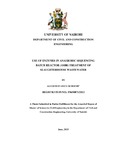| dc.description.abstract | Slaughterhouse wastewater if not adequately treated has potential for environmental degradation including contamination of groundwater, deoxygenation of rivers and clogging of soil pores. In Kenya, treatment of slaughterhouse wastewaters to meet standards for discharge into public sewers faces several challenges such as high organic load in excess of 11,500 mg/L COD, lack of funding for conventional treatment methods and inadequate land for construction of waste stabilization ponds.
Anaerobic sequencing batch reactors (ASBRs) provide effective and economical alternative for the treatment of organic loads that are released intermittently. The reactors accomplish treatment of wastewater in four phases namely, feed, react, settle and draw, sequentially in a single reactor. However, conventional ASBRs operate with sophisticated control systems for monitoring and adjustment of the system to optimum operating conditions. Omission of controls owing to their high costs and skill requirements would result in unsatisfactory effluents. Therefore, there is need for improvement of the ASBR operated without control system to allow effluent discharge to public sewers. An effective improvement of ASBR performance can be achieved by the use of enzymes which have been widely used to aid wastewater treatment processes. Enzymes accelerate biochemical reactions in cells by lowering their activation energy.
This study evaluated the viability of proprietary enzyme secreting bacteria culture, Ecotreat®, in ASBR treatment of slaughterhouse wastewater from
iii
Dagoretti slaughterhouses in Nairobi. The study was carried out using three bench scale reactors with Ecotreat® bacterial culture applied at 0 (control), 0.5 and 1.0% of slaughterhouse effluent and a volume exchange ratio (VER) of 40%. The enzymatic assisted ASBR treatment achieved up to 91 and 50% reduction of COD and TSS, respectively, within 8-hour reaction time. Application of the Ecotreat® bacterial culture at 1% concentration enhanced the ASBR reduction of COD by 14%. The treatment met the EMCR (2006) requirements for discharge into public sewers of less than 1,000 mg/L COD after 16 days of operation and therefore would allow discharge without recirculation. The ASBR effluents had BOD5/COD ratio of 0.52 to 0.59 indicating they were readily biodegradable and, therefore, amenable to biological treatment in municipal wastewater treatment plants. The study recommends further investigations of enzymatic assisted ASBR treatment to establish the steady state performance. | en_US |

